Alexandre de Faria, Patrick Smytzek, Zsuzsanna Gaspar, and Maximilian Manderscheid
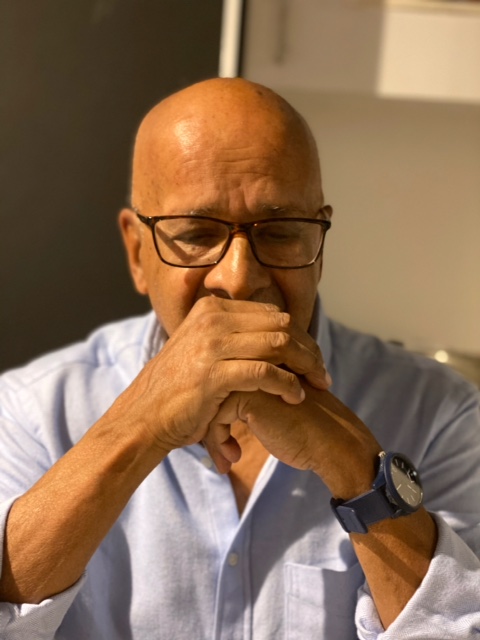



Glossary[2]
| Socio-ecological system: | A socio-ecological system consists of ‘a bio-geo-physical’ unit and its associated social actors and institutions. Socio-ecological systems are complex and adaptive and delimited by spatial or functional boundaries surrounding particular ecosystems and their problem context. |
| Sustainability: | A dynamic equilibrium between a socio-ecological system and its environment, which enables the system to maintain itself and its functionality in order to produce desired outcomes. This is not a static process but requires constant monitoring, evaluation, learning and adaptation. |
| Resilience: | Resilience is the ability of a socio-ecological system to adapt to and cope with changes in its environment and continue to thrive and renew itself. |
| Transition: | A transition is a change within the current identity of the system. It might involve the adaption of new technologies (e.g. green energy sources, new management practices) and the learning of the necessary skills and knowledge. |
| Transformation: | A transformation is a change which touches the very identity of the system. After a transformation, the system is constructed differently by the interest groups involved. The beliefs about the identity of the system and the role of the participant agents in it have changed. Different and new values guide action. From this change in the understanding of the own role within the system and the nature of the system itself new opportunities arise and new development trajectories become possible. Transformation might also result in new institutions being established. |
A TRANSFORMATION OF DEVELOPMENT PROCESSES[3]

THINKING DIFFERENT ABOUT “DEVELOPMENT”
Some fundamental issues
Our subjective perception is that development initiatives over the past 5 decades have not had the desired impact on human development[4]. With this perception we do not stand alone in the world of so-called development cooperation. Society and its institutions are organised to achieve planned results based on linear approaches (e.g. Logical Framework Approach – LFA) rather than understanding that society works in the form of complex systems. Generally speaking, development agencies:
- are driven by projects that are required by management to be limited in time and space to achieve outcomes that are relevant to solving problem areas identified several years earlier;
- do not take into account the fact that the project stakeholders and the world around them are changing all the time and that the outcomes produced may no longer be relevant or sustainable in the changed context. Moreover, they are often built on assumptions about change which do not hold true in the course of the life of the project;
- very often imply a power imbalance between the donors, the operative entity, and the recipients of the project.
More importantly, national and international development agencies – be they governmental or non-governmental – have developed their own culture, values, and attitudes in the course of time – these routines include competing rather than collaborating for the benefit of the intended “beneficiaries”.
Thus, ownership of a development initiative is critically important for ensuring that learning and a transition can be sustained by those who feel the current unsatisfactory situation and have designed the initiative. Unfortunately, ownership has remained elusive largely due to ineffective use of an array of excellent participatory methods (such as SAR – Systemic Action Research) and coaching tools by leaders and facilitators. More often than not the participation of “beneficiaries” has been hampered. They tend to feel inhibited in terms of knowledge, know-how, status in front of experts on whom they know they depend on for support and personal development. Participatory workshops, substantive papers and reporting have very often been unconsciously or consciously “manipulated” in various ways.

How to “think different”[5]?
We need to think in terms of co-evolving complex adaptive systems (CAS)[6] – away from linear approaches applying processes in a routine fashion. A system is defined as a group of interacting, interrelated, and interdependent human and non-human actors that form a complex and unified whole[7]. A system co-evolves through the actions and interactions of its components and with its environment – through a process of self-organisation (autopoeisis).
A CAS has its own identity: the whole is larger than the sum of its parts. Individual human beings and society as a whole are continuously adapting to their environment / living conditions. Humans can be seen as open systems that exchange material and informational flows with their environment and fellow human beings. While human beings are open CAS (biologically as well as psychologically), they make things happen in the systems in which they live. Their actions and behaviour are driven by what they believe and perceive to be most important to them[8]. Each person is unique and no one’s behaviour will be the same in all conditions; each one adapts over time and has an impact on others in the system. There is a feedback loop between structure and agency: collective agency enacts structures, which again influence the agency of the individuals in the system. Structuralism and individual agency are therefore two sides of the same coin rather than contradictory principles.
Through interactions and networking, people learn from each other – not always in a positive, deliberate and conscious manner. They acquire new knowledge, capabilities and skills with which to improve how they carry out their daily activities (incremental change). However, deeper learning can lead to changing the way people think, their worldviews, what they value most and consider most important in their daily activities etc. – these are the drivers of creativity and innovation and of how they behave in their daily work practice leading to transformative change through a number of transitions.
Interactions between people with similar / same values and beliefs generally constitute leverage points for change in a whole system and may lead to scaling an innovation horizontally and vertically to meso- and macro- levels[9]. Communication, participation, learning, co-ownership, co-leadership and co-responsibility in development initiatives are keys to effective change.
Last but not least, there is an urgency for researchers, policy-makers (including funding agencies), practitioners and communities to collaborate on development issues rather than to work separately. They also need to consider how rural communities are increasingly affected by the world’s interrelated systemic crises[10] (health, education, hunger, poverty, inequalities, migration flows, economic, financial, fundamentalisms, ecology, corruption, etc).
We suggest that development agencies, NGOs and other actors:
- View development more as a bottom-up process rather than as a top-down finite limited project in which complex systems co-evolve in line with changes in their environment. This gives rise to new ideas, inventions, innovations and human development[1], building on the creativity and drivers inherent in the system. Development is a never-ending process supported by long-term initiatives. This is difficult to do today given that development institutions’ administrations and budgets operate on the basis of biennia.
- Treat communities not as homogenous entities but appreciate their diversity and take into account power dynamics and processes of marginalisation, dispossession and exclusion.
- Engage in co-leadership, remembering that leadership needs to be integrative, systemic, recognising the stakeholder diversity with diverse value systems[2]. Leadership cannot be based on “egocentric”, “authoritarian”, “enterprising” ways of thinking alone.
- Value people in communities – not as just “resources” like technology, finance, materials, and equipment – but as having a life of their own and being placed with all their complexities at centre-stage of development initiatives. In particular, they need to focus on everyone engaged in such initiatives and on their specific ways of thinking, their value systems, beliefs, motivation and working traits, aspirations[3].
- Acknowledge the intimate relationship human communities have with the natural environment.
To
incorporate the above changes into daily work practice, institutional leaders
will need to enact the corresponding policies and priorities, processes and
procedures to enable them to work in a frame of complex adaptive systems. In
other words, a change of organisational purpose, beliefs, values (i.e.
transformative change) is essential if there is to be a tangible and sustained
impact on the world of change and development.
LEVELS OF LEARNING, TRANSITIONS AND TRANSFORMATIVE CHANGE
Transitions leading to transformative change need to be resilient given disturbances occurring both within and outside an ecosystem. To achieve re-alignment, there are at least three conditions that need to be met:
- Cumulative multi-level learning,
- Effective participation resulting in ownership of an innovation,
- Scaling an innovation beyond the system to couple and integrate with others systems.
The art of a facilitator / leader is in being able to nudge diverse stakeholders bottom-up through different levels of learning to ensure that participation ensures ownership, and nudge scaling of the community’s innovations beyond the community to couple and integrate with other systems.
Cumulative multi-level learning
Since change is a permanent feature of any system, learning is always required to cope with its ever-changing life conditions. Learning and change result from the influence impact of interactions with other stakeholders in and around a community as well as with prevailing life conditions at regional, national levels and very often at global levels. Through time, people will be accumulating additional or new knowledge, supported by values and beliefs (about those values) that enable the improvement of their actions and behaviours in their daily work (Fig.1)[14].
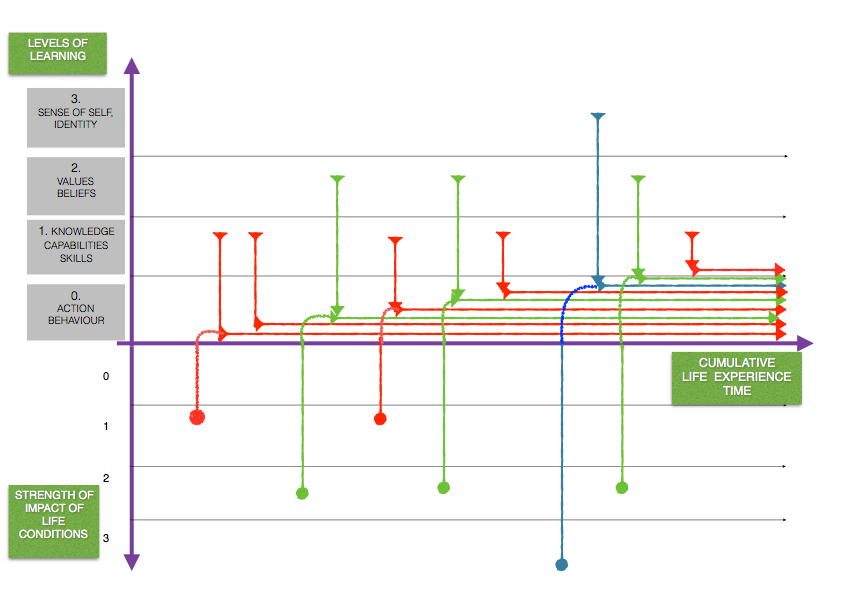
Nevertheless, when a system (community) is aligned with its life conditions – and is satisfied with its livelihood situation and wellbeing – then there is no apparent drive or motive to change its daily work practice (actions, behaviours); it is in a state of habituation where learning is apparently neither sought nor called for (learning level 0).
However, when a community experiences dissatisfaction with its livelihoods and wellbeing, (that is, when it is not aligned with its life conditions), then learning and change will be required. If learning cannot take place for whatever reason, then the system is said to be in a “stuck state”. However, when learning can and does take place, then the system can achieve re-alignment with its life conditions (dynamic stability; eco-social resilience).
The influence or impact of these interactions may lead a community through a process of transformative learning to acquire (Fig. 2):
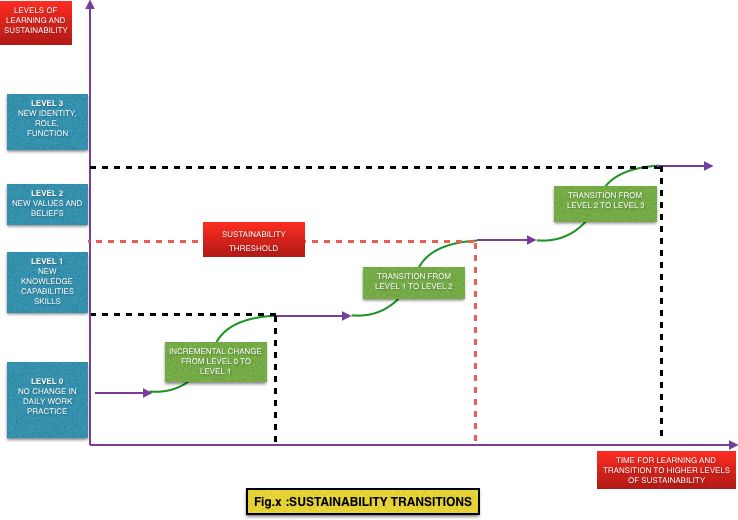
Note:
- Learning and change can have either a positive or a negative effect on the system and its alignment with prevailing life conditions;
- A transition can only be sustained when there is a continuous alignment of people and communities with their life conditions (dynamic stability) — that is, as they are conditioned by other systems (institutions) around them;
- These other systems will also be experiencing change in their actions and behaviour in daily work; and probably in their institutional priorities, leadership, processes; and eventually in their culture, beliefs in their values and purpose (role, function).
Transitions require effective participation, ownership and co-leadership
In the development context, learning is the result of stakeholder participation in daily work, meetings of experts, participatory workshops etc. It should lead to ownership, which is critically important for ensuring that a transition can be sustained. Bateson’s work on the levels of learning[15] led Robert Dilts and others to postulate that a human being is at his best in terms of performance and wellbeing when he is at one with himself and with what he is doing. At that point ownership is at its highest level, that is when the person is aligned at five levels:
- Identity — his sense of self, mission in life is supported by and influences your …
- Values and beliefs about those values — what she believes to be true about for example smallholder farmer communities. These influence her choice and use of her…
- Knowledge, capabilities and skills …
- In his actions / behaviour in daily work practice …
- In the context of her or his work environment and the prevailing life conditions.
If any level is not aligned with the others or with prevailing life conditions, he will not produce his best performance and will most likely not be in a state of wellbeing. The same line of thought is true for social systems such as rural communities or others when not aligned with other systems with which they interact giving rise to dynamic instability.
The key lies in the effectiveness of communication by leaders or facilitators together with relational skills that take into account stakeholders’ values, beliefs, motivation and working traits etc.[16]. In addition, to overcome this critical obstacle to sustainable transitions, Jules Pretty has built on Arnsteins ladder and identified 7 levels of participation[17] from a purely passive presence to full involvement / ownership of decision making and of developing ideas and proposals for a community’s advancement.
The process of participation, learning and taking ownership
of a development initiative provides the space for the emergence of
stakeholders with capacity to facilitate and lead the community. These are
likely to engage in various forms of collaborative leadership / co-leadership.
Transitions when scaling an innovation (system coupling)
Transitions can also be sustained when a system evolves from a micro-level system (niche innovations), through meso- (regime) to macro-level systems (landscape). Elzen, Geels and others[18] have explored this in depth. At this point, complexity increases considerably as the community needs to move from the design and testing of niche innovations at the micro-level[19] to integrating them within the broader context with:
- a network of actors, social groups and institutions that adapts over time to the system dynamics; a set of formal and informal rules that address the behaviours and the actions of actors in order to steer the socio–technical system; (iii) a set of material and technological components;
- the overall socio-economic, ecological, technical, political context that can have a considerable impact at both regime- and niche-levels.
Fig. 3 below attempts to show the process of scaling in a simple manner: it represents 3 systems in the form of institutions with their sense of purpose/responsibility; their cultural values and beliefs; their policies, strategy, processes.
Given these attributes, the stakeholders from the niche system / institutions interact in their daily work with those from the regime and landscape system/institutions in a given eco-system. As the quality and quantity of interactions intensify, positive and constructive learning is likely to be translated into improved policies, strategy, processes in their respective systems and hence into improved collaboration and increased efficiency and effectiveness of stakeholders’ daily tasks.
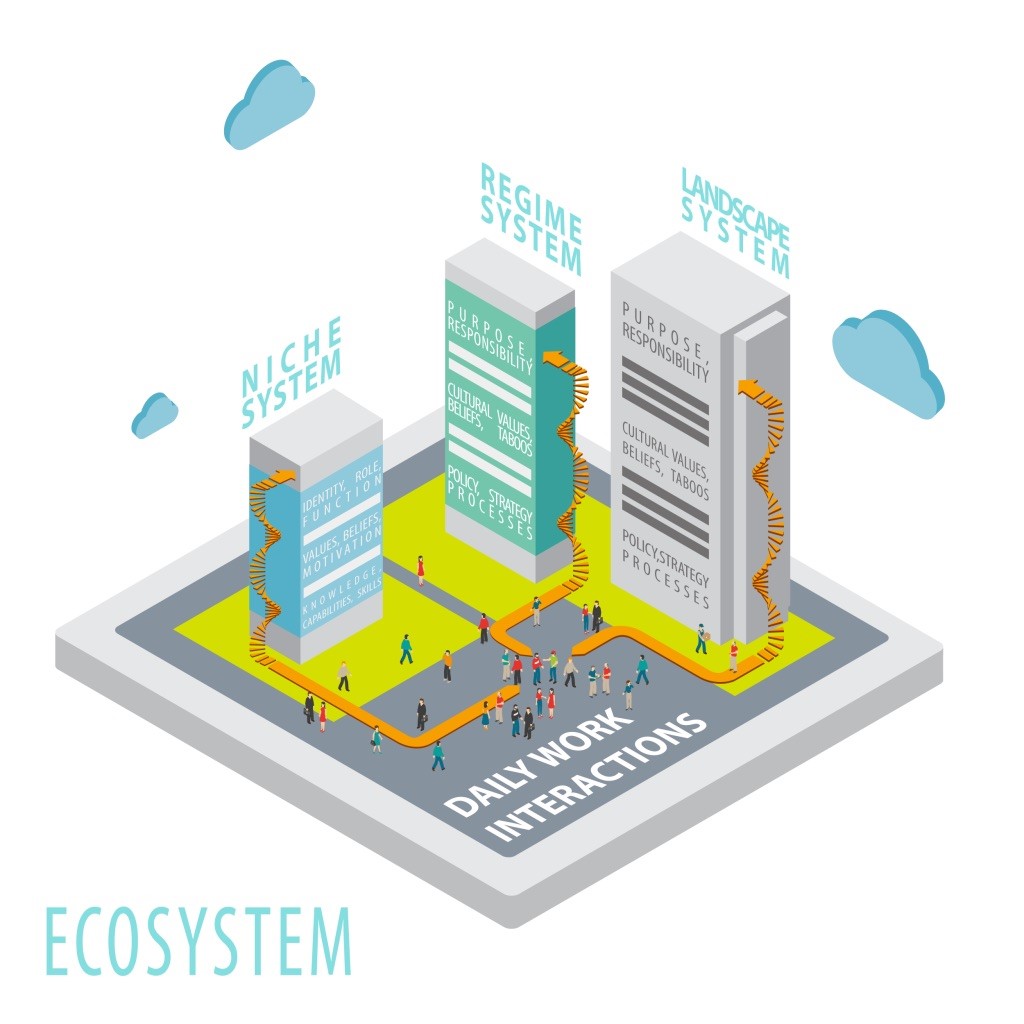
Knowledge creation[20] may eventually give rise to a convergence of niche and regime systems’ predominant cultural values and beliefs, motivation and working traits, their worldviews. As such leverage points emerge, they can lead to an integration of these systems[21]. And indeed, they may lead to a change in the institutions’ mission, purpose. Such is the nature of a transformative (deep) change. The same system integration process may also involve the landscape level system / institutions. At this stage the original niche innovation will have found all the support required from regime and landscape level systems to secure its success.
THE WAY FORWARD[22]
Co-designing a road map
The U process[23] describes an archetypical change process at the individual or collective level. It is a framework that can be used as a road map by the complexity facilitator to steer through the unknown territory of change towards an ecosystem’s stability, resilience and wellbeing for the communities concerned.
We need to first assess the point of departure and the dimensions of a socio-ecological systems instability (the reason for a complexity facilitation process).
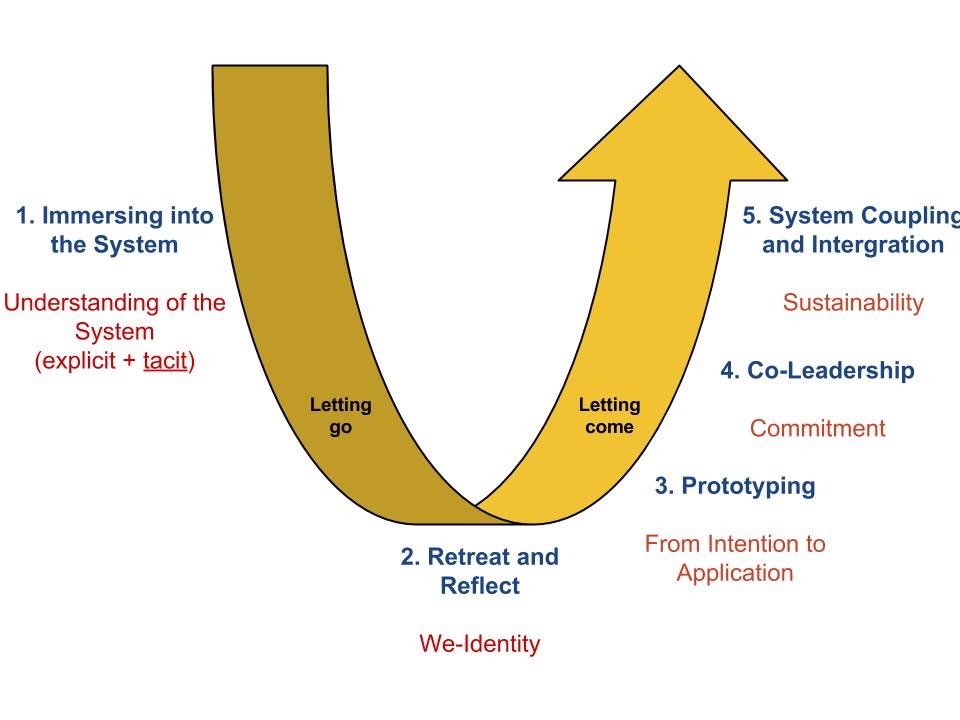
The U process can be applied to each of the three transitions in Fig. 2 above.
The five stages in the U process:
- Immersing into the system: the aim is to gather information and insights about the system from various perspectives (different actors) and on different levels (factual, emotional, intuitive). This stage will facilitate a profound understanding of the internal and external aspects involved as well as of existing multi-level perspectives (micro-, meso-, macro-levels) and multi-time perspectives (in- and through time; mid- and long-term). This stage will ideally result in the identification of alignments, misalignments and leverage points within a system.
- Inner Reflection: Knowledge creation happens through the interaction of tacit and explicit knowledge[1]. The facilitator needs to design an empty space, where the stakeholders can connect to this tacit knowledge and let it surface. This is an individual and a collective process structured around contemplation and dialogue. The facilitator and participants need to deal with the fear to leave the known and step into the unknown. Participants reflect on their role in the system, create a “We” identity that has a crucial meaning for the stakeholders. The outcome is an impressionist’s vision for the future.
- New ideas, pilot product initiatives and niche market testing: This vision needs to be explored through an iterative process in which something new can emerge. Several pilot initiatives are co-developed for niche testing and for demonstrating the key-features of the desired results. A feedback loop allows for continuously improvement and testing and co-leadership emerges. The outcome is dynamic stability strategy that will need to be adjusted as continuous change takes place in the alignment between relevant systems. The innovation emerges through this iterative process.
- Co-leadership / co-responsibility: The resilience and dynamic stability of the development initiative is dependent on a strong and continuous belief in a shared sense of ownership and responsibility. The facilitator needs to hand over the leadership to emerging leaders within the community. The outcome is a strong shared commitment for the innovations.
- System coupling and integration: Frommicro- (niche) to meso- (regime) to macro- (landscape) level systems.Toscale and disseminate the innovation, system coupling and integration[2] needs to occur vertically – establishing the innovation in neighbour communities – as well as horizontally – building relationships on to the meso- and macro level, which allow to further nurture the innovation and build resilience. The creation of hubs, where communities can learn from each other is a promising attempt to couple systems (see also Fig. 3 above). The community leaders / facilitators nudge the system in this direction – identifying likely leverage points – while keeping an eye on the systems’ dynamic stability.
Monitoring transitions in co-evolving complex systems
The prime purpose of monitoring is to check changes in the alignment / misalignment between individuals and systems; as such, it needs to be carried out from the perspectives of the facilitator, individual farmers, farmer associations (or similar), and the wider systems within which they operate. Monitoring the implementation of a development initiative has to be iterative, adaptive and flexible — there can be no recipe or step-by-step method.
Nevertheless, there are certain principles that need to be observed. Monitoring should be seen as an on-going process that seeks to understand the evolution of the system as a whole as well as of its sub-systems; it is also designed to:
- Monitor the quality and quantity of stakeholder interactions and interdependency;
- Nurture feedback loops whenever necessary and support learning;
- Monitor changes in the development initiative’s context;
- Identify leverage points that can influence the co-evolution of the systems;
- Reveal the direction the system is moving and what has triggered this move;
- Provide a basis for indicating if this direction is compatible with its sustainability strategy and plans and deciding on actions might be required.
It might need to review the adopted strategy and to assess the extent to which its value systems and beliefs might need to change to another stage of human evolution; it might even have to revisit the “We-Identity” that emerged from the Inner Reflection stage of the U journey to ensure that co-ownership still holds true for all main stakeholders.
Complexity facilitation[26]
Current leadership needs to adapt to the nature of CAS. This paper argues that a co-evolutionary process involving dynamic stability transitions can be nurtured through “complexity facilitation” – an iterative process to enable actors in a rural community to co-design their own development pathway. “Complexity facilitators” or “complexity leaders” are conscious that complex adaptive systems can be most creative when they are at the edge of chaos. This is when creativity and new ideas leading to invention and possible innovations appear – often in unexpected directions.
Complexity facilitators can nudge the system towards re-alignment with its life conditions (towards resilient/sustainable livelihoods and wellbeing). They blend, align, integrate, coalesce diverse perspectives and interests in order to establish a common base on which interest groups commit to their own common vision and purpose[27]; it supports co-ownership and co-leadership.
In short a complexity facilitator:
- Creates the space in which actors, both individually and collectively, are free to learn and engage in innovation and transformative change while ensuring full and effective participation and ownership of their development process.
- Enables actors in a community to make sense of the system they are in and then to co-design and co-lead their own path towards resilient/sustainable livelihoods that provide for food, income and overall wellbeing.
- Has no set recipe / steps to be taken; the complexity facilitator has systemic, integral set of values, and goes with the flow of the stakeholders in the system. The facilitator makes careful use of “nudging” techniques.
- Is a master in the use of effective communication and relational skills.
Furthermore, since all reality is subjective, the facilitator needs to take into account:
- Human beings’ have preferred ways of learning and learn at different levels[1];
- Multi-perspectives i.e. the perspectives offirst, second, third, ‘n’ person;
- Multi-system perspectives i.e. of diverse professional and social groups;
- Multi-level perspectives: micro-, meso-, macro-levels;
- Multi-time perspectives: thinking in-time, through-time; mid- and long-term.
THE NEXT STEPS
The above approach, process and methods have been applied by GOAL separately in various contexts related to both international and organisational development. However, they have not been tested as a whole with regard to a specific community from a stage where it is experiencing disturbances to a stage where its people are experiencing a high degree of wellbeing — dynamic stability of their eco-system. Such a test is important in order to obtain data evidence that the approach and process are efficient and effective.
The approach is a basis for transforming the “how” of development initiatives. That is, towards a focus on people and – at the same time – on processes aimed at communities’ dynamic stability, eco-resilience and well-being as well as increased profitability.
ANNEX: LEVELS OF PARTICIPATION, CO-OWNERSHIP AND CO-LEADERSHIP[29]
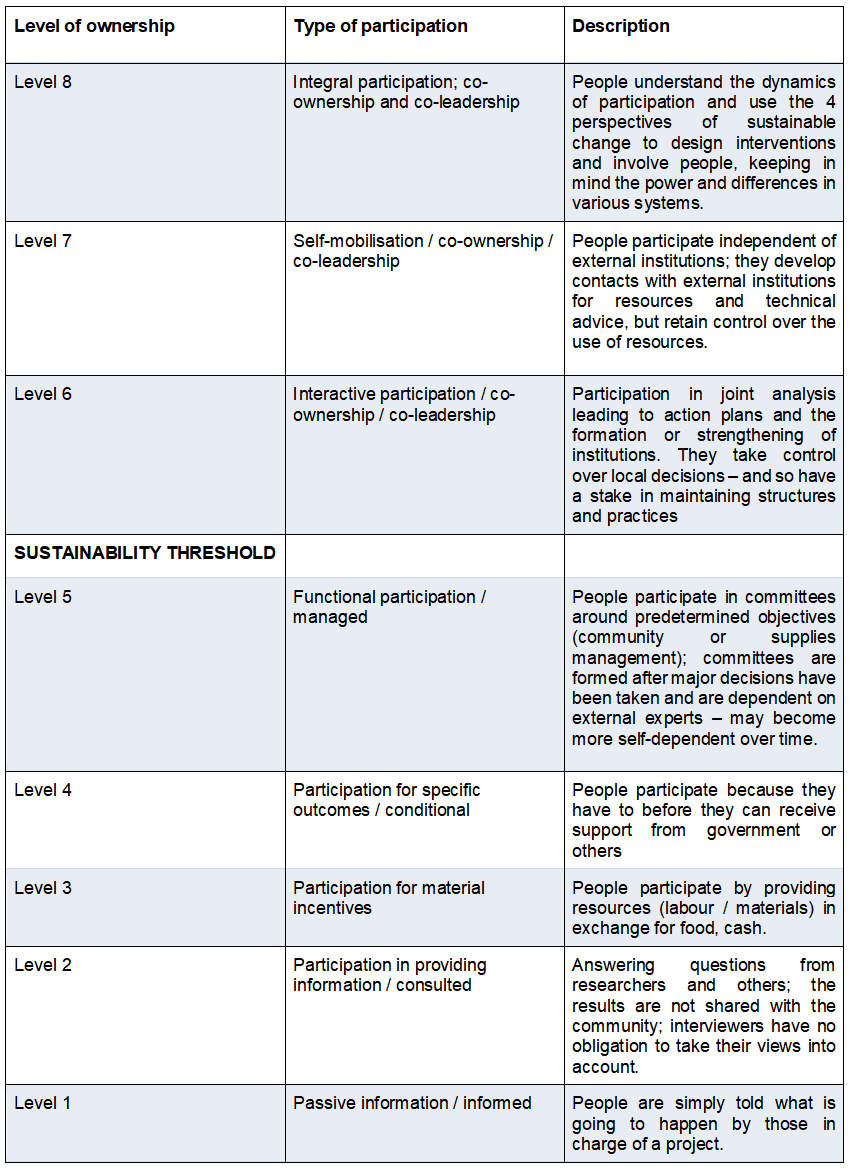
Footnotes
[2] based on terminology used in the fields of complex adaptive systems and resilience thinking
[3] A similar pattern of “systems thinking” seems to be behind the transformation programme designed bottom-up in France since April 2016. It is based on several thousand people participating in local working groups, followed by the identification by technical experts of a series of integrated priority programmes for implementation at national level.
[4]This results from direct personal and organisational experience acquired over 25 years from the appraisal of development programmes and projects worldwide and the moderation of numerous project design workshops.
[5] Burns, D. & Worsley, S. (2015). Navigating Complexity in International Development. Rugby UK, Practical Action Publishing.
[6] Brown, B. (2011). Complexity Leadership. An overview and key limitations. Integral Leadership Review. https://en.pdf24.org
[7] Coffman, J. (2007). A Framework for Evaluating Systems Change Initiatives. http://buildinitiative.org/WhatsNew/ViewArticle/tabid/96/ArticleId/621/Framework-for-Evaluating-Systems- Initiatives.aspx
[8] SAM –“Systemic Alignment Model” derived from Bateson (1972) and Dilts (1998). See de Faria, A. (2004). The People Dimension in Development and Development Co-operation, paper prepared for The Quality Assurance Company, Vienna.
[9] Meadows, D. (1999). Leverage Points: Places to Intervene in a System. The Sustainability Institute. http://donellameadows.org/wp-content/userfiles/Leverage_Points.pdf
[10] Gauthier, A. (2011). Emerging Concepts and Forms of Integral Leadership: Embodying a Radically New Development Paradigm, Integral Leadership Review. http://integralleadershipreview.com/3978-emerging-concepts-and-fo…egral-leadership-embodying-a-radically-new-development-paradigm
[11] Hargreaves, T., Haxeltine, A., Longhurst, N., & Seyfang, G. (2011). Sustainability transitions from the bottom-up: Civil society, the multi-level perspective and practice theory. Working Paper – Centre for Social and Economic Research on the Global Environment, 1–26.
[12] This coincides with the “Integrative” stage of the Graves / Beck SDI model / Integral Theory in the evolution of human development. People’s mental models (worldviews) may evolve through life from an informal (premodern) to a conventional (modern) to alternative (post-modern) and to a systemic (integral) way of thinking.
[13] We tend, unintentionally or unconsciously, to “impose” our own values and beliefs through our programmes and the mind-sets of our experts. We tend not to listen to so-called “beneficiaries” who also have their own values, beliefs, motivation and working traits given their living conditions and cultural environment. They need to be motivated the way they like to be motivated.
[14] SAM -‘Systemic Alignment Model derived from Bateson (1972) and Dilts (1998). See de Faria, A. (2004). The People Dimension in Development and Development Co-operation, paper prepared for The Quality Assurance Company, Vienna.
[15] Bateson, G. (1968). The Logical Levels of Learning and Communication, paper presented at the Conference on World Views, National Institute of Mental Health.
[16] de Faria, A. (2003). Communication and Relational Skills for Leaders and Facilitators. A manual prepared for UNEP, Paris.
[17] Pretty, J. N. (1995). Participatory learning for sustainable agriculture. World Development 23, 1247–1263. See also Annex: Levels of participation, co-ownership and co-leadership.
[18] Elzen, B. et al., C. Normative contestation in transitions “in the making”: Animal welfare concerns and system innovation in pig husbandry. Research Policy, 40(2), p. 263-275. Available at: http://www.sciencedirect.com/science/article/pii/S0048733310002118
[19] Falcone, P. M. (2014). Sustainability Transitions: A Survey of an Emerging Field of Research. Environmental Management and Sustainable Development, 3(2), 61.
[20] Nonaka, I., Toyama, R., Konno, N. (2000). Seci, Ba and Leadership: a Unified Model of Dynamic Knowledge Creation. Long Range Planning, 33(1), 5-34.
[21] Meadows, D. (1999). Leverage Points: Places to Intervene in a System. The Sustainability Institute.
[22] Dynamic agility to surf the waves of change:
“Life is about the evolution of my Self though time; quality of life is about the meaning I attach to my relationships with human beings and everything else around me. The meaning I attach to these relationships emerges from my daily life experience as I learn from everyone and everything in my environment.
The art of living and wellbeing is about dynamic agility. It is about how comfortable I feel and am with continuous change around me on my path of evolution. This implies reflecting my inner Self in my daily behaviour and actions; it also implies being in a dynamic balance with the culture and behaviour of society around me.
Trying to maintain a dynamic stability stimulates my agility to search for new ways to find a new balance – this is the permanent state we live in and leads us to take risks, to create and to innovate.”
[23] Scharmer, O. and Kaufer, K. (2013). Leading From the Emerging Future: From Ego-system to Eco-system Economies. Berret-Koehler Publishers.
[24] Nonaka, I., Toyama, R., Konno, N. (2000). Seci, Ba and Leadership: a Unified Model of Dynamic Knowledge Creation. Long Range Planning, 33(1), 5-34.
[25] Rammel, C., Stagl, S., & Wilfing, H. (2007). Managing complex adaptive systems – A co-evolutionary perspective on natural resource management. Ecological Economics, 63(1), 9–21.
[26] Complexity facilitation differs markedly from other forms such as: traditional flatland facilitation (or moderation) is limited to communication between people in workshops, panel discussions etc. This facilitator often gets involved with substantive content. Flatland facilitation does not seek sustainable change. “Systems facilitation” occurs in organisational development using models such as the European Excellence model, the Malcolm Baldridge Award, Kaizen that are largely determined by an organisation’s constitution, purpose, and culture. A systems facilitator does not normally deal with the people’s mindsets, although the leaders’ mindset is sometimes considered through executive coaching. Systems facilitation is generally limited to incremental change – and does not result in transformative change at the level of people and their organisation.
[27] See http://www.integratedsociopsychology.net/meshworks-perspective-process.htm
[28] Bateson, G. (1972). Steps to an Ecology of Mind: Collected essays in anthropology, psychiatry, evolution, and epistemology. University of Chicago Press, Chicago.
[29] Based on:
- Pretty J. N. (1995). Participatory learning for sustainable agriculture. World Development, 23(8), 1247-1263. https://doi.org/10.1016/0305-750X(95)00046-F
- “Integral Mentors: Participation, Ownership and Development”, Worlds of Inclusion 019. https://www.facebook.com/integralMENTORS
About the Authors
Alexandre (Rico) de Faria
Co-leadership Team
Complexity facilitator, coach, trainer; External Lecturer at the
Centre for Development Research/BOKU University in Vienna
about the co-evolution of complex adaptive systems in
international development. Former Chief, Project Appraisal /
Quality Assurance, United Nations Industrial Development
Organisation. Specialization: quality of management of
international development, LFA/PCM, systemic alignment –
SAM, organisational development, leadership communication
and relational skills, Integral Theory, Spiral Dynamics Integral,
Theory U, Bohmian Dialogue, NLP.
defaria@goalnetwork.com
Patrick Smytzek is a voluntary member of GOAL’s co-leadership team. International cooperation expert focused on climate change issues with
experience in Southeast Asia, East- and West-Africa. Work experience with global programmes and organisational development processes. Areas of expertise: Climate change adaptation, natural resource management, participatory action research. Professional interests: transformational processes and anticipatory governance. smytzek@goalnetwork.com
Zsuzsanna Gaspar is a voluntary member of GOAL’s co-leadership team with focus on methodology. M.Sc. in Computer Science, IT Architect, she is also specialized in the application of the Integral Theory to human and organizational development such as in the study carried out by GOAL on the social integration of a Roma community.
Maximilian Manderscheid is currently taking part in a research project and doing his PhD in urban agriculture and the participatory development of scenario methods. Studied Water Management & International Organic
Farming at Wageningen University and Research (WUR) and the University of Natural Resources and Life Sciences (BOKU), Vienna. Worked for Heitger Consulting a systemic consultancy dealing with the issues of sustainability in organizations (CSR) and in research projects and international development in Nepal, India, Ethiopia and Somaliland including systems
thinking, participation, participatory modeling. manderscheid@goalnetwork.com
